Category
Photographic Preservation
3 entries in this category | view all categories
Photograph: Meet Frame
Posted February 2020 in Conservation, Framing, New Additions, Photographic Preservation, PhotoSeed, Significant Photographers
Last August I had the uncommon opportunity to purchase five photographs ca. 1905-1910 that were still in their original picture frames taken by William T. Knox, (1863-1927) then president of the Brooklyn Camera Club.
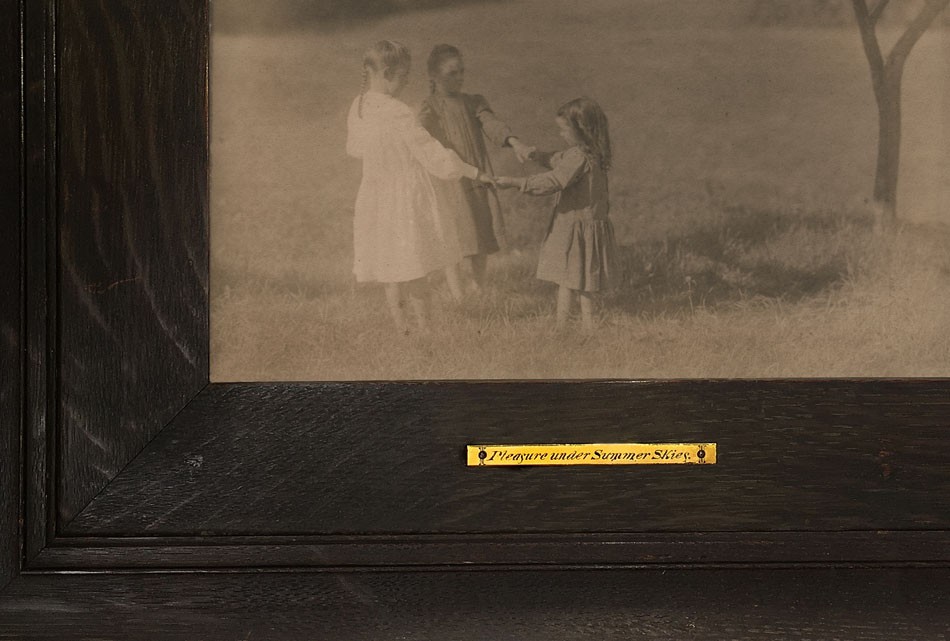 Detail: “Pleasure Under Summer Skies”: William T. Knox, American: (1863-1927) Vintage sepia Platinum print ca. 1905-10; 19.6 x 24.5 | 19.6 x 24.5 cm (flush-mounted on Bristol-board type matrix). Photograph framed in quarter-sawn oak frame with brass title nameplate made by James Engle Underhill, American: (1870-1914) two-piece integrated: 34.5 x 39.5 x 2.0 cm shown with glass removed. “Pleasure Under Summer Skies” dates to 1905, and was initially exhibited in the Second American Photographic Salon, overseen by the American Federation of Photographic Societies under President Curtis Bell. At the time, William Knox was Federation Secretary. From: PhotoSeed Archive
Detail: “Pleasure Under Summer Skies”: William T. Knox, American: (1863-1927) Vintage sepia Platinum print ca. 1905-10; 19.6 x 24.5 | 19.6 x 24.5 cm (flush-mounted on Bristol-board type matrix). Photograph framed in quarter-sawn oak frame with brass title nameplate made by James Engle Underhill, American: (1870-1914) two-piece integrated: 34.5 x 39.5 x 2.0 cm shown with glass removed. “Pleasure Under Summer Skies” dates to 1905, and was initially exhibited in the Second American Photographic Salon, overseen by the American Federation of Photographic Societies under President Curtis Bell. At the time, William Knox was Federation Secretary. From: PhotoSeed Archive
Additionally, three of them were in beautiful wood frames made by his fellow club member James E. Underhill, 1870-1914, who I discovered had made his living as a fine picture framer since around 1900 in New York City at his shop at 33 John Street, at the corner of Nassau Street.
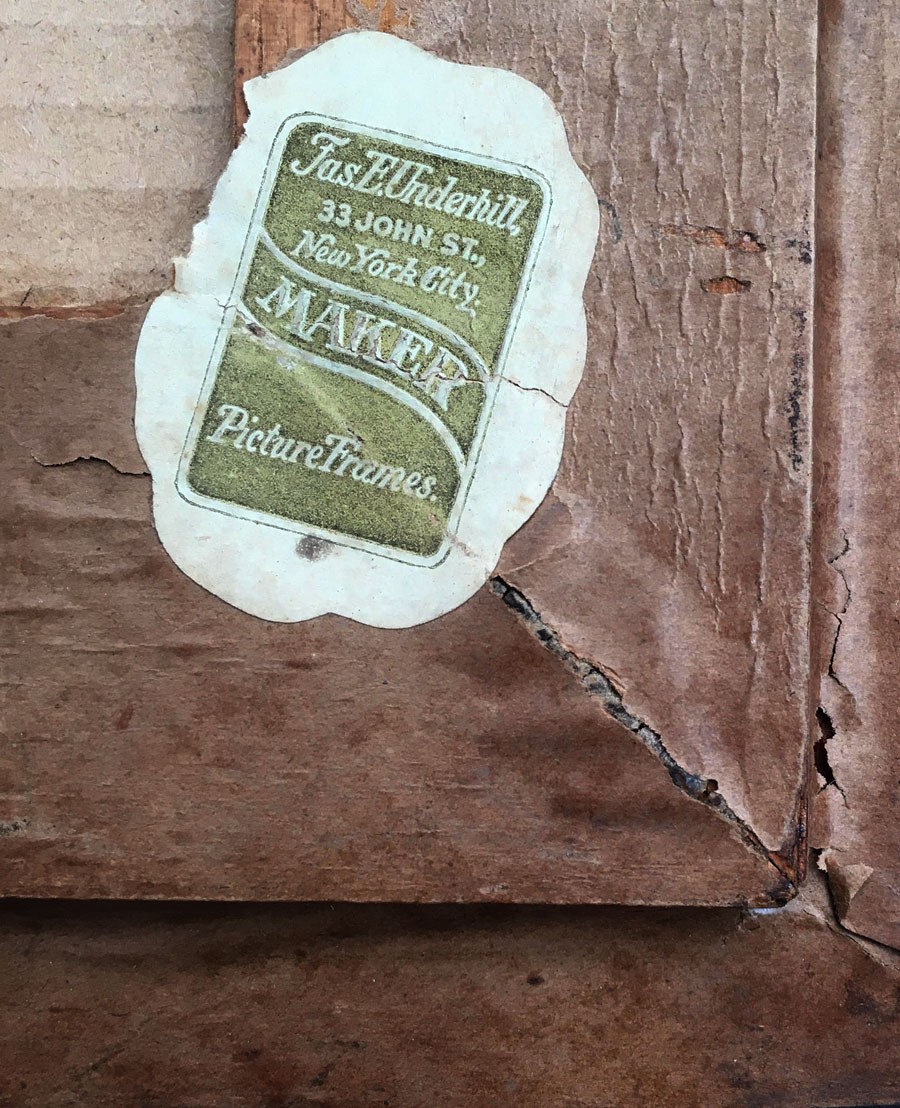 Before limited conservation, the original James E. Underhill white-paper letterpress label in olive-green (2.9 x 2.0 | 4.3 x 3.2 cm) is seen affixed to the frame backing verso of his oak frame enclosing the William T. Knox photograph “Pleasure Under Summer Skies”. Conservation treatment by this archive carefully left this label in place. James Engle Underhill was a fellow member along with Knox at the Brooklyn Camera Club when this photograph was taken and framed. (ca. 1905-10) Underhill’s picture framing shop: “Jas.E.Underhill, 33 John St., New York City. MAKER PictureFrames.” was in operation at this location (corner Nassau) from around 1900 to his death in 1914. From: PhotoSeed Archive
Before limited conservation, the original James E. Underhill white-paper letterpress label in olive-green (2.9 x 2.0 | 4.3 x 3.2 cm) is seen affixed to the frame backing verso of his oak frame enclosing the William T. Knox photograph “Pleasure Under Summer Skies”. Conservation treatment by this archive carefully left this label in place. James Engle Underhill was a fellow member along with Knox at the Brooklyn Camera Club when this photograph was taken and framed. (ca. 1905-10) Underhill’s picture framing shop: “Jas.E.Underhill, 33 John St., New York City. MAKER PictureFrames.” was in operation at this location (corner Nassau) from around 1900 to his death in 1914. From: PhotoSeed Archive
In my 20+ years of collecting photography, and with a definite impression the “bloom is off the rose” when it comes to the intersection of internet commerce, it seems to me today more difficult to acquire vintage photographs of artistic note still in their original frames. This is a pity, because framed photographs left undisturbed from 100+ years ago can often reveal the more honest intent photographers wished for their work to be seen and appreciated- for the time they were created no doubt, but also on a higher aesthetic level.
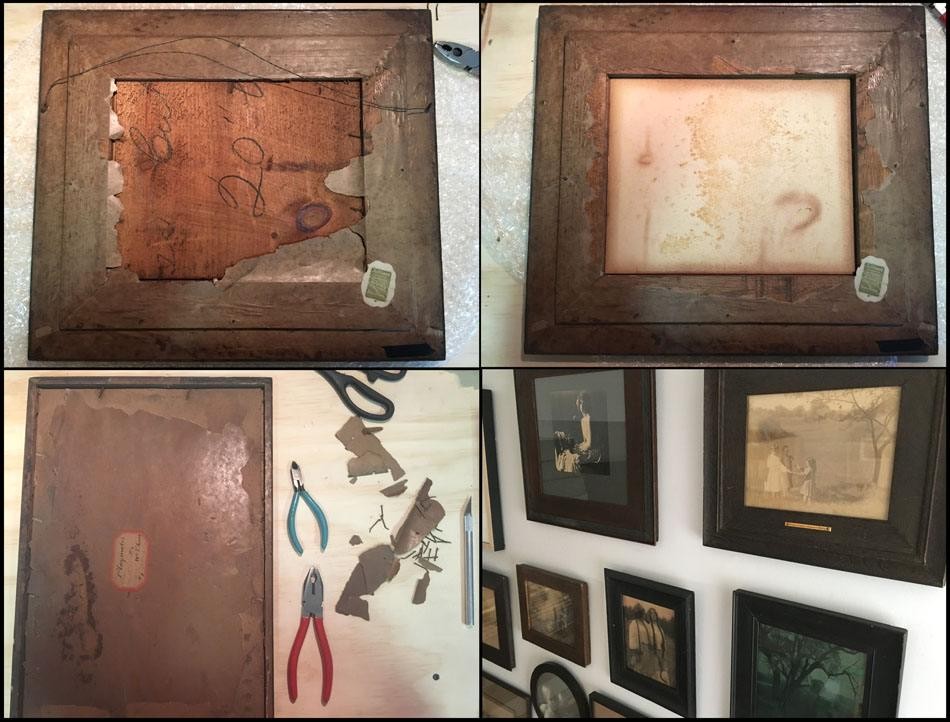 Upper left: When first received by PhotoSeed after purchase in late August, 2019, the verso of the framed William T. Knox photograph “Pleasure Under Summer Skies” is seen in its’ original James E. Underhill oak frame. As was common in framed works from the late 19th and early 20th centuries, a thin sheet of pine wood veneer was used as a backing board, secured by small nails. Upper Right: Conservation treatment on the framed work included removal of this wood backing board along with rusted screw-eyes and wiring used for hanging as well as some of the frame backing paper. The original Underhill framing label is carefully left undisturbed at lower right and the Bristol-board type matrix with flush-mounted photograph on recto is revealed, showing the “burning in” of several wood knot holes from the recto of the original sheet of wood veneer. Next steps included the thorough cleaning of the original framing glass and then cutting a piece of acid-free, 4-ply mat board that would be sandwiched between the photographic matrix and new piece of cardboard backing board. Finally, a Fletcher brand framing gun was used to secure glass, mounted photograph and the two separate backing matrixes using new metal framer’s points to the inside perimeter of the frame verso. Lower Left: Tools at right including small pliers and a wire-cutter were used to remove the original verso framing nails from the William T. Knox photograph “Playmates”, along with an X-Acto knife at far right to cut away the delicate and very acidic backing paper. A unique paper label signed and titled by the artist in the middle of the paper was then carefully removed and preserved within a newly encapsulated frame using a piece of acid-free mat board. New flush-mounted hanging hardware (screw-eyes not recommended!) and braided wire were also installed. Lower Right: A selection shows vintage frames with photographs from the PhotoSeed Archive, including the William T. Knox photograph “Pleasure Under Summer Skies”, now re-installed within its’ original James E. Underhill frame at upper right. To the left of it is a separate frame made by Underhill’s contemporary, George F. Of Jr. (1876-1954) From: PhotoSeed Archive
Upper left: When first received by PhotoSeed after purchase in late August, 2019, the verso of the framed William T. Knox photograph “Pleasure Under Summer Skies” is seen in its’ original James E. Underhill oak frame. As was common in framed works from the late 19th and early 20th centuries, a thin sheet of pine wood veneer was used as a backing board, secured by small nails. Upper Right: Conservation treatment on the framed work included removal of this wood backing board along with rusted screw-eyes and wiring used for hanging as well as some of the frame backing paper. The original Underhill framing label is carefully left undisturbed at lower right and the Bristol-board type matrix with flush-mounted photograph on recto is revealed, showing the “burning in” of several wood knot holes from the recto of the original sheet of wood veneer. Next steps included the thorough cleaning of the original framing glass and then cutting a piece of acid-free, 4-ply mat board that would be sandwiched between the photographic matrix and new piece of cardboard backing board. Finally, a Fletcher brand framing gun was used to secure glass, mounted photograph and the two separate backing matrixes using new metal framer’s points to the inside perimeter of the frame verso. Lower Left: Tools at right including small pliers and a wire-cutter were used to remove the original verso framing nails from the William T. Knox photograph “Playmates”, along with an X-Acto knife at far right to cut away the delicate and very acidic backing paper. A unique paper label signed and titled by the artist in the middle of the paper was then carefully removed and preserved within a newly encapsulated frame using a piece of acid-free mat board. New flush-mounted hanging hardware (screw-eyes not recommended!) and braided wire were also installed. Lower Right: A selection shows vintage frames with photographs from the PhotoSeed Archive, including the William T. Knox photograph “Pleasure Under Summer Skies”, now re-installed within its’ original James E. Underhill frame at upper right. To the left of it is a separate frame made by Underhill’s contemporary, George F. Of Jr. (1876-1954) From: PhotoSeed Archive
On a technical note, PhotoSeed does minimum conservation on framed works when they enter the collection. The mantra of “do no harm” as well as the realization of being temporary custodians of an archive is embraced. When in doubt about proceeding with photographic conservation, advice given me many years ago from a George Eastman Museum conservator to basically just leave things alone when unsure of how to proceed is something I’ve always kept in mind. Of course, the financial realities of proper conservation standards will always be at the forefront for collectors, both private and institutional.
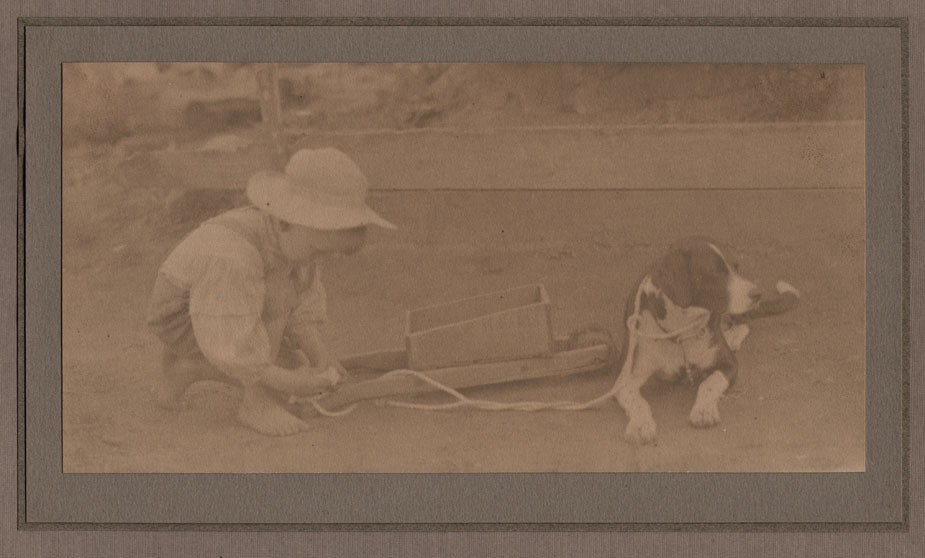 “Playmates”: William T. Knox, American: (1863-1927) Vintage sepia Platinum print ca. 1905-10; image: 12.0 x 23.5 mounted on fine art papers: 19.6 x 24.5 | 19.6 x 24.5 cm. This fine children’s genre study by Brooklyn Camera Club president William T. Knox dates to 1905 or slightly before as it was known to have been exhibited in the Second American Photographic Salon that year. It shows a young child attaching a leash from his faithful canine companion to his toy wooden wheelbarrow. From: PhotoSeed Archive
“Playmates”: William T. Knox, American: (1863-1927) Vintage sepia Platinum print ca. 1905-10; image: 12.0 x 23.5 mounted on fine art papers: 19.6 x 24.5 | 19.6 x 24.5 cm. This fine children’s genre study by Brooklyn Camera Club president William T. Knox dates to 1905 or slightly before as it was known to have been exhibited in the Second American Photographic Salon that year. It shows a young child attaching a leash from his faithful canine companion to his toy wooden wheelbarrow. From: PhotoSeed Archive
Frame Conservation: A Few Ideas
For framed works, conservation on my end typically includes the removal of acidic frame backing materials and replacement with acid-free mounting materials that come into direct contact with the physical print. Embedded dirt and other foreign matter is then carefully removed and or wiped away from the frame itself, with original finishes showing the passing of decades left deliberately intact and never stripped off. Finally, everything is put back together for storage or display: the original glass from the frame is also cleaned on both sides and then carefully put back into place. If cracks are discovered or worse, replacement with a custom cut piece of window glass will typically suffice.
Digital Presentation on PhotoSeed
For digital presentation on this website, the frame is then photographed separately and the print scanned. I use Photoshop to combine the two-leaving the original framing glass out. Purists may object to this but I’m not changing the physical object in any way-just taking advantage to present you with an optimum web experience. Of course, the joy of collecting is being able to appreciate a vintage photograph in the very best form possible: in person. Never the less, I’ve included a small photo along with three other conservation snaps in this post showing a small display of conserved and “reframed” works from this archive. Other examples can be found here.
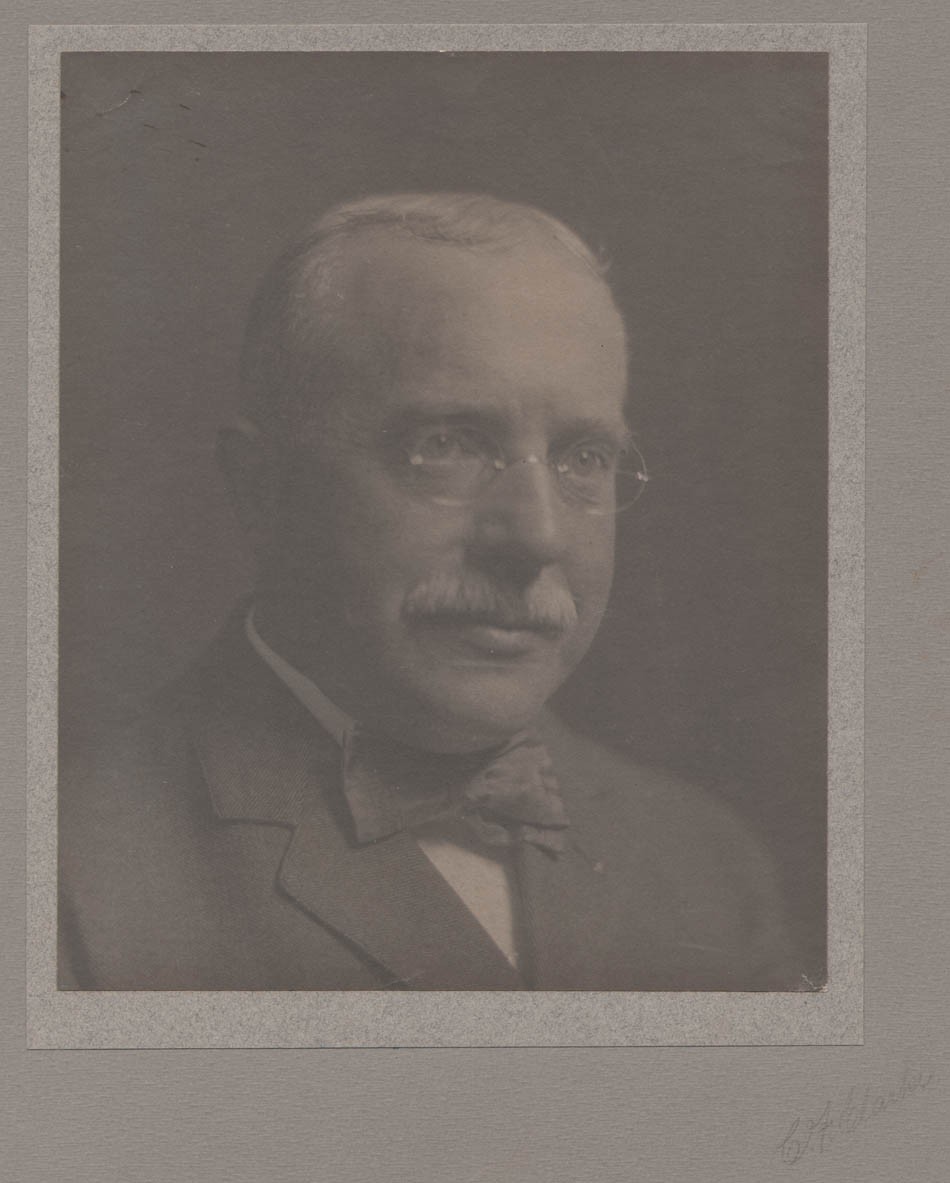 “Portrait: Brooklyn Camera Club President William T. Knox”: Charles Frederick Clarke, American, born Nova Scotia: (1865-1912) image: 21.7 x 17.8 cm; supports: light-gray art paper 23.7 x 19.4 | 36.4 x 29.5 cm; Vintage platinum print ca. 1905-10. William T. Knox (1863-1927) was an important American amateur photographer and promoter of photography from Brooklyn, New York. From at least 1891-1915, he was a partner of McCormick, Hubbs & Co., importers and commission merchants in West India and Florida Fruits and Produce with offices at 279 Washington Street in New York City. (Manhattan) From: PhotoSeed Archive
“Portrait: Brooklyn Camera Club President William T. Knox”: Charles Frederick Clarke, American, born Nova Scotia: (1865-1912) image: 21.7 x 17.8 cm; supports: light-gray art paper 23.7 x 19.4 | 36.4 x 29.5 cm; Vintage platinum print ca. 1905-10. William T. Knox (1863-1927) was an important American amateur photographer and promoter of photography from Brooklyn, New York. From at least 1891-1915, he was a partner of McCormick, Hubbs & Co., importers and commission merchants in West India and Florida Fruits and Produce with offices at 279 Washington Street in New York City. (Manhattan) From: PhotoSeed Archive
Intriguingly, I have owned a platinum portrait of William T. Knox, showing him to be quite the dapper gentleman- mustachioed, and sporting a bow tie taken about the same time he was club president, for many years prior to my collecting any of his actual photographs. This was by Charles F. Clarke, 1865-1912, (American, born Nova Scotia) an amateur and business agent for the Forbes Lithograph Company of Springfield, MA.
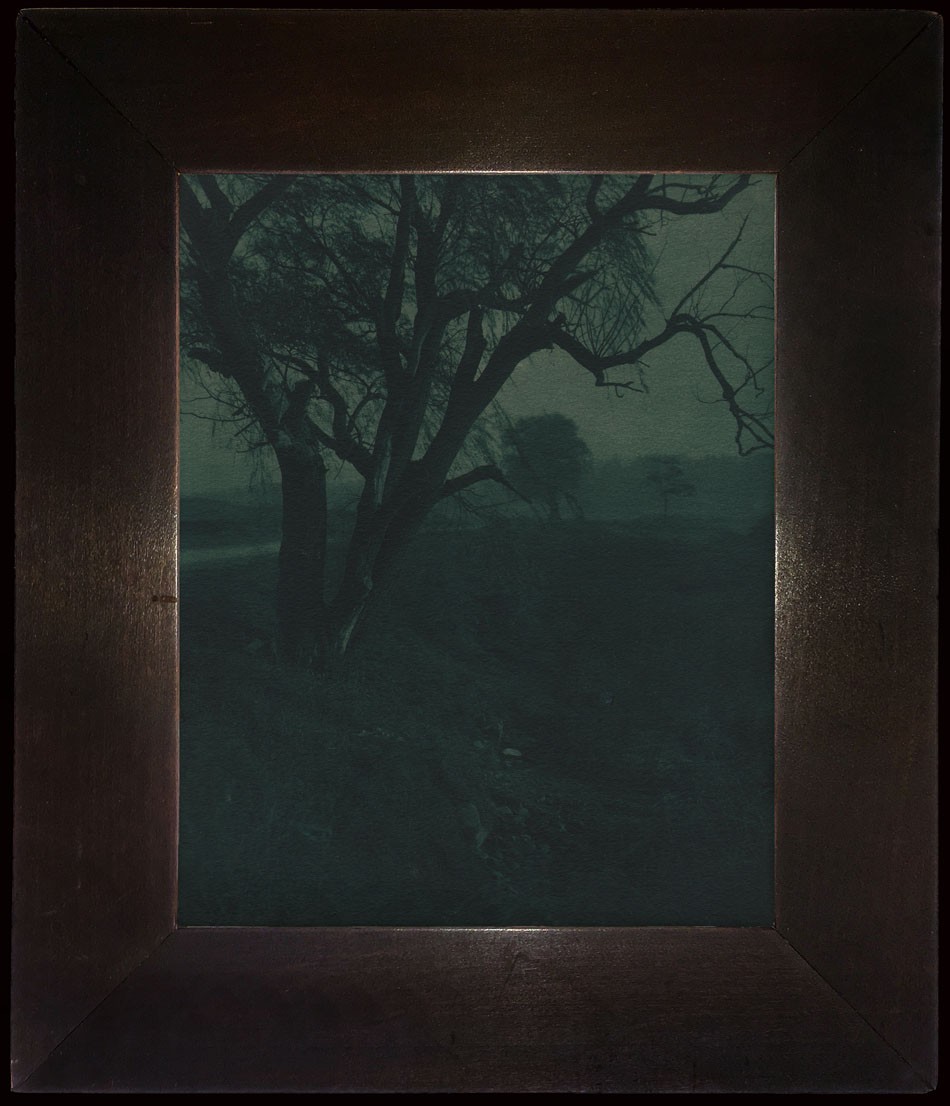 “Landscape in Green Carbon”: attributed to William T. Knox, American: (1863-1927) Vintage green Carbon print ca. 1905-10; image: 23.4 x 19.7 cm flush mounted to thick, Bristol-board type matrix: 23.6 x 19.7 cm shown within its’ original oak frame: 32.6 x 28.6 x 2.0 cm (with glass removed) by James E. Underhill (1870-1914) of New York City. Knox and Underhill were members of the Brooklyn Camera Club when this photograph was taken and framed. From: PhotoSeed Archive
“Landscape in Green Carbon”: attributed to William T. Knox, American: (1863-1927) Vintage green Carbon print ca. 1905-10; image: 23.4 x 19.7 cm flush mounted to thick, Bristol-board type matrix: 23.6 x 19.7 cm shown within its’ original oak frame: 32.6 x 28.6 x 2.0 cm (with glass removed) by James E. Underhill (1870-1914) of New York City. Knox and Underhill were members of the Brooklyn Camera Club when this photograph was taken and framed. From: PhotoSeed Archive
You can see all of Mr. Knox’s framed works in the collection here, which includes a professional chronology for his friend the framer and fellow Brooklyn Camera Club member James E. Underhill. Happy hunting! -David Spencer
Kodak City: the Sequel
Posted April 2018 in Cameras, Conservation, Exhibitions, History of Photography, Photographic Preservation, Photography, Publishing
Speaking of photography in general, of which this website is particularly enamored of, our recent visit to Rochester, New York and attendance in the three-day conference “PhotoHistory/PhotoFuture” sponsored and organized by RIT Press and The Wallace Center at the Rochester Institute of Technology gave new meaning to their claims for the medium: “there has never been more of it than there is today.” That might be stating the obvious, especially in 2018, but the new meaning part was my own takeaway and inspiration.
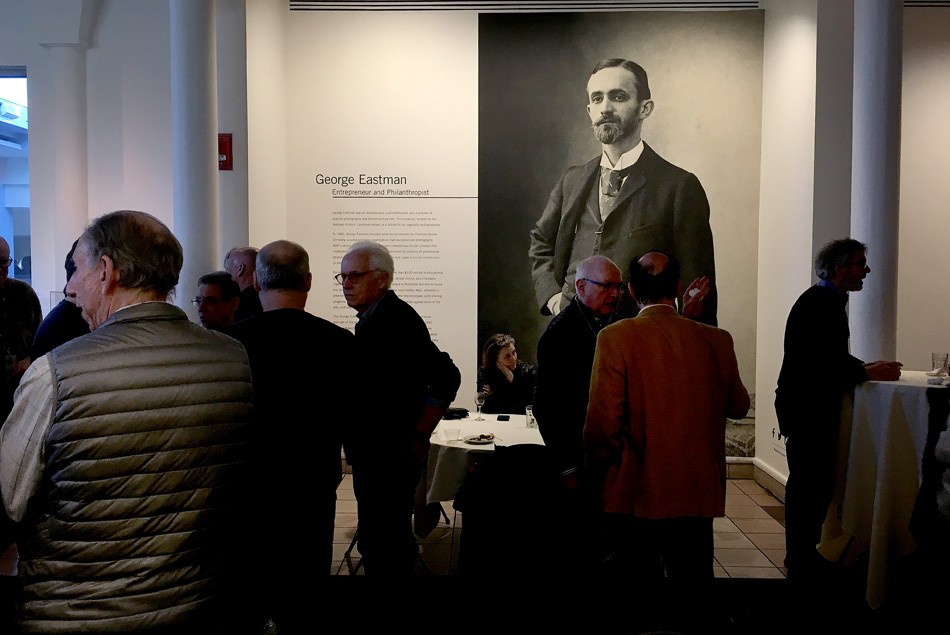 By George, Still Relevant: During a reception at the George Eastman Museum for conference attendees, a young George Eastman,(1854-1932) who founded the Eastman Kodak Company, looms larger than life in a photograph taken in 1890 by Nadar. Entrepreneur and Philanthropist are emphasized on the wall label, and with good reason. From the museum's website:"The George Eastman Museum is located in Rochester, New York, on the estate of George Eastman, the pioneer of popular photography and motion picture film. Founded in 1947 as an independent nonprofit institution, it is the world’s oldest photography museum and one of the oldest film archives. The museum holds unparalleled collections—encompassing several million objects—in the fields of photography, cinema, and photographic and cinematographic technology, and photographically illustrated books. The institution is also a longtime leader in film preservation and photographic conservation." David Spencer for PhotoSeed Archive
By George, Still Relevant: During a reception at the George Eastman Museum for conference attendees, a young George Eastman,(1854-1932) who founded the Eastman Kodak Company, looms larger than life in a photograph taken in 1890 by Nadar. Entrepreneur and Philanthropist are emphasized on the wall label, and with good reason. From the museum's website:"The George Eastman Museum is located in Rochester, New York, on the estate of George Eastman, the pioneer of popular photography and motion picture film. Founded in 1947 as an independent nonprofit institution, it is the world’s oldest photography museum and one of the oldest film archives. The museum holds unparalleled collections—encompassing several million objects—in the fields of photography, cinema, and photographic and cinematographic technology, and photographically illustrated books. The institution is also a longtime leader in film preservation and photographic conservation." David Spencer for PhotoSeed Archive
In present day Kodak city, the power of ideas relating to what made this place significant as an imaging industrial behemoth still exists, but has now gone in a new direction. With all due apologies, but the pun indeed appropriate, a snapshot of those ideas put forth by the conference attendees and speakers shows their passion for the medium’s minutiae both preserves and continues this essential democratic language. Those of memories past surely, but more and more the future in the form of ones and zeroes hurtling forward.
Although the “Big Yellow” of Rochester’s past is long gone, the ideas nourishing photography’s entire corpus continues apace, an alternate reality both present and future. For those curious enough, the RIT conference program along with a list of presenters can be found here, along with a few photos from the weekend courtesy of yours truly. David Spencer-
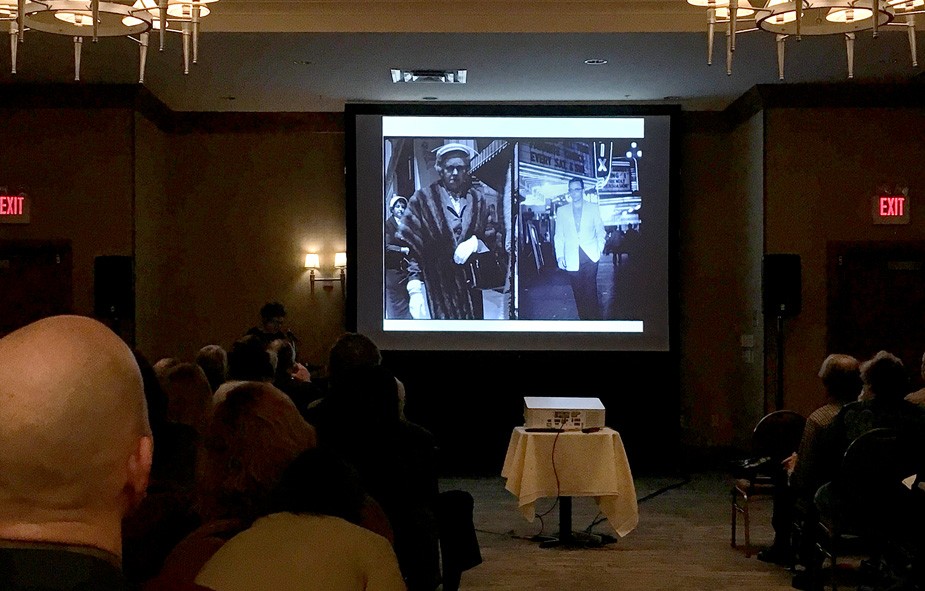 Documentary photography practiced as commerce on busy streets around the world, a genre roughly known as "Movie Snaps" because of the retrofitted movie cameras used in their making, was part of a fascinating presentation under the working title “Street Vendor Portraits Around the World: Czernowitz, Capetown, San Francisco, More!” given by independent scholar Mary Panzar of Rochester. Here, the hybrid look of Winogrand meeting Arbus becomes a document in a projected frame of a woman sporting fur and white gloves at left while a gentleman unaware at right emerges to flash and instant celebrity from a movie theatre on a nighttime street. David Spencer for PhotoSeed Archive
Documentary photography practiced as commerce on busy streets around the world, a genre roughly known as "Movie Snaps" because of the retrofitted movie cameras used in their making, was part of a fascinating presentation under the working title “Street Vendor Portraits Around the World: Czernowitz, Capetown, San Francisco, More!” given by independent scholar Mary Panzar of Rochester. Here, the hybrid look of Winogrand meeting Arbus becomes a document in a projected frame of a woman sporting fur and white gloves at left while a gentleman unaware at right emerges to flash and instant celebrity from a movie theatre on a nighttime street. David Spencer for PhotoSeed Archive
 Triptych in the Dark: Left: During his presentation “Did Talbot Make Daguerreotypes?”, the eminence of English photography pioneer William Henry Fox Talbot (1800-1877) is shown here by an image most in attendance had seen, yet Grant Romer- formerly of the Eastman House but now Founding Director of the Academy of Archaic Imaging, challenged us with another view: a decidedly unflattering profile of the paper/negative pioneer he rightly remarked might have made for a different public perception for the emerging medium had it been the lone evidence of his existence. Middle: a quote of photographic philosophy by American writer Susan Sontag (1933-2004) struck this observer as particularly relevant in the present day- University of Illinois Springfield professors Kathy Petitte Novak and Brytton Bjorngaard used it as supporting evidence while speaking on “The Blurring Distinctions of Taking versus Making Photographs: Teaching Photography in a Digital Culture”. Right: the appropriated late Victorian era reality of the dark underbelly of a small Wisconsin town through the lens of Black River Falls photographer Charles Van Schaik repurposed by author Michael Lesy in his 1973 cult classic "Wisconsin Death Trip" was supporting material for Nicolette Bromberg of the University of Washington, who argued photographic archivists need to understand context in her paper “Loss of Vision: How Art Historians and Critics Misjudge Early 20th Century Photography and How Early Photographers Along with Art Museums and Archives Help to Obscure the Photographic Record”. David Spencer for PhotoSeed Archive
Triptych in the Dark: Left: During his presentation “Did Talbot Make Daguerreotypes?”, the eminence of English photography pioneer William Henry Fox Talbot (1800-1877) is shown here by an image most in attendance had seen, yet Grant Romer- formerly of the Eastman House but now Founding Director of the Academy of Archaic Imaging, challenged us with another view: a decidedly unflattering profile of the paper/negative pioneer he rightly remarked might have made for a different public perception for the emerging medium had it been the lone evidence of his existence. Middle: a quote of photographic philosophy by American writer Susan Sontag (1933-2004) struck this observer as particularly relevant in the present day- University of Illinois Springfield professors Kathy Petitte Novak and Brytton Bjorngaard used it as supporting evidence while speaking on “The Blurring Distinctions of Taking versus Making Photographs: Teaching Photography in a Digital Culture”. Right: the appropriated late Victorian era reality of the dark underbelly of a small Wisconsin town through the lens of Black River Falls photographer Charles Van Schaik repurposed by author Michael Lesy in his 1973 cult classic "Wisconsin Death Trip" was supporting material for Nicolette Bromberg of the University of Washington, who argued photographic archivists need to understand context in her paper “Loss of Vision: How Art Historians and Critics Misjudge Early 20th Century Photography and How Early Photographers Along with Art Museums and Archives Help to Obscure the Photographic Record”. David Spencer for PhotoSeed Archive
 Photographic Preservation: With a mission statement stating they are the "world leader in the development and deployment of sustainable practices for the preservation of images and cultural heritage", conference attendees toured the Image Permanence Institute, (www.imagepermanenceinstitute.org) which opened in 1985 as an academic research laboratory within the College of Imaging Arts and Sciences at RIT. For many visitors, IPI is known for their Graphics Atlas, (www.graphicsatlas.org) an online resource that helps identify photographic and other process print types. In front of a table with various displayed print types including a row of portraits toned with Polysulfide & Selenium Toner, Institute senior research scientist Douglas Nishimura at left chats with a visitor. David Spencer for PhotoSeed Archive
Photographic Preservation: With a mission statement stating they are the "world leader in the development and deployment of sustainable practices for the preservation of images and cultural heritage", conference attendees toured the Image Permanence Institute, (www.imagepermanenceinstitute.org) which opened in 1985 as an academic research laboratory within the College of Imaging Arts and Sciences at RIT. For many visitors, IPI is known for their Graphics Atlas, (www.graphicsatlas.org) an online resource that helps identify photographic and other process print types. In front of a table with various displayed print types including a row of portraits toned with Polysulfide & Selenium Toner, Institute senior research scientist Douglas Nishimura at left chats with a visitor. David Spencer for PhotoSeed Archive
 Conference participants attended the exhibition "The Luminous Print: An Appreciation of Photogravure" organized by David Pankow, Curator Emeritus for the Cary Graphic Arts Collection at RIT now running through June 15, 2018. With beginnings in intaglio printing by artists working in the late 15th Century, photogravure's historical timeline which evolved by the 19th Century as a medium for "images from real life" is showcased by superb examples featuring plates from bound volumes, portfolios and individual works. The pleasure in real life can be seconded by this attendee, with the following observation from the catalogue true to form: "enjoy this exhibition for the beauty of its images alone and discover why it has been said that a photogravure print is endowed with a luminosity unequalled by any other process."David Spencer for PhotoSeed Archive
Conference participants attended the exhibition "The Luminous Print: An Appreciation of Photogravure" organized by David Pankow, Curator Emeritus for the Cary Graphic Arts Collection at RIT now running through June 15, 2018. With beginnings in intaglio printing by artists working in the late 15th Century, photogravure's historical timeline which evolved by the 19th Century as a medium for "images from real life" is showcased by superb examples featuring plates from bound volumes, portfolios and individual works. The pleasure in real life can be seconded by this attendee, with the following observation from the catalogue true to form: "enjoy this exhibition for the beauty of its images alone and discover why it has been said that a photogravure print is endowed with a luminosity unequalled by any other process."David Spencer for PhotoSeed Archive
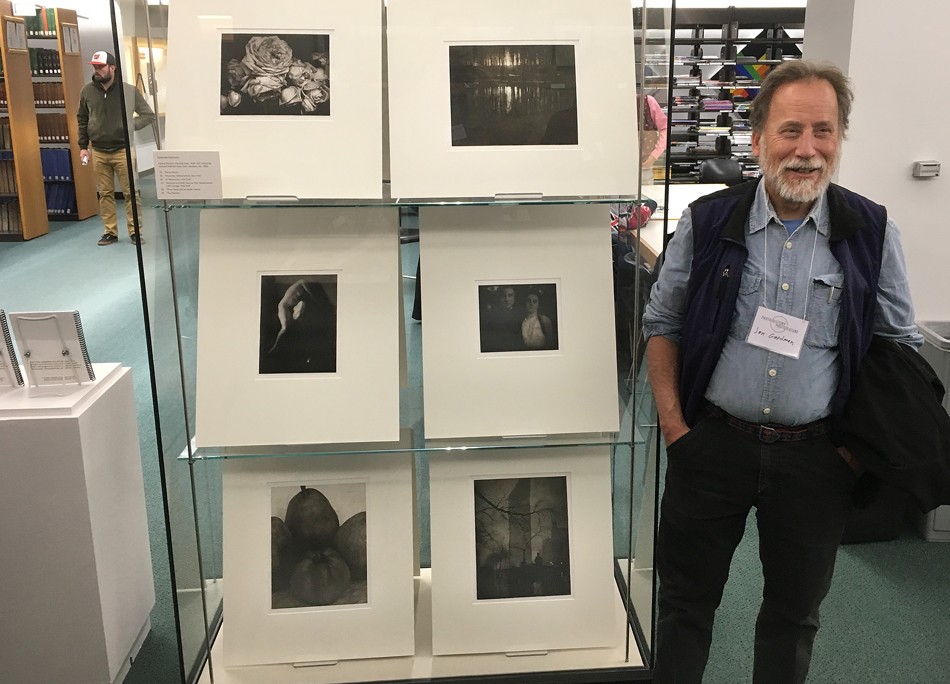 Royal Visit: As an added bonus, conference attendees viewing "The Luminous Print" could rub shoulders with Massachusetts resident Jon Goodman, a master craftsman who has worked full time since 1976 as a photogravure printer specializing in the Talbot Klic photogravure technique . Beginning in 1980 through the Photogravure Workshop, a division of the Aperture Publishing Foundation and their namesake Aperture magazine and the Paul Strand Foundation, Jon has produced sumptuous, superb, and collectable portfolios of the early work of Paul Strand, Edward Steichen, and British photography. His mission continues today in his Florence, MA atelier along with a new interest: carbon printing. Displayed are six of Jon's gravure plates featuring the pictorial work of Edward Steichen from the 1981 Aperture portfolio: "Edward Steichen; The Early Years, 1900-1927". Top to bottom left to right: "Heavy Roses", "Moonrise, Mamaroneck, New York", "In Memoriam, New York", "Steichen and Wife Clara on their Honeymoon, Lake George, New York", "Three Pears and an Apple, France", "The Flatiron". Visit jgoodgravure.com and gravureportfolios.com for more information. David Spencer for PhotoSeed Archive
Royal Visit: As an added bonus, conference attendees viewing "The Luminous Print" could rub shoulders with Massachusetts resident Jon Goodman, a master craftsman who has worked full time since 1976 as a photogravure printer specializing in the Talbot Klic photogravure technique . Beginning in 1980 through the Photogravure Workshop, a division of the Aperture Publishing Foundation and their namesake Aperture magazine and the Paul Strand Foundation, Jon has produced sumptuous, superb, and collectable portfolios of the early work of Paul Strand, Edward Steichen, and British photography. His mission continues today in his Florence, MA atelier along with a new interest: carbon printing. Displayed are six of Jon's gravure plates featuring the pictorial work of Edward Steichen from the 1981 Aperture portfolio: "Edward Steichen; The Early Years, 1900-1927". Top to bottom left to right: "Heavy Roses", "Moonrise, Mamaroneck, New York", "In Memoriam, New York", "Steichen and Wife Clara on their Honeymoon, Lake George, New York", "Three Pears and an Apple, France", "The Flatiron". Visit jgoodgravure.com and gravureportfolios.com for more information. David Spencer for PhotoSeed Archive
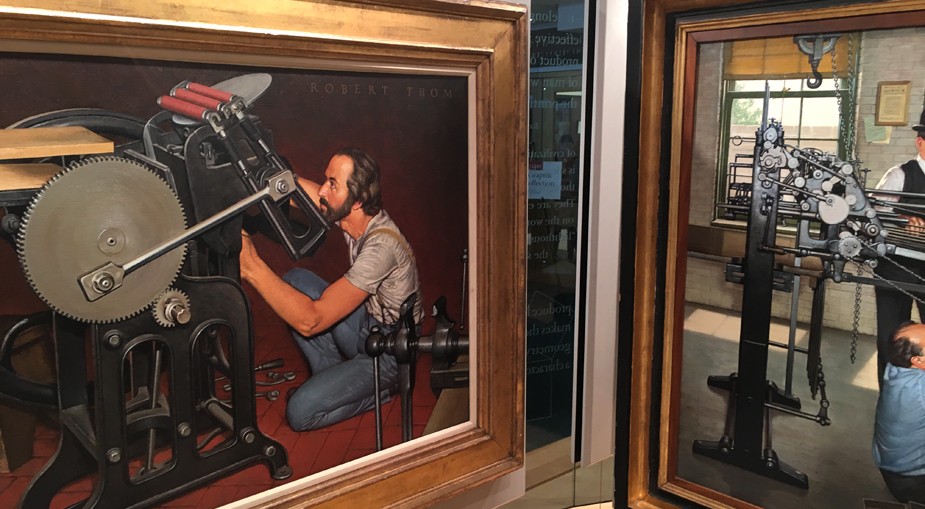 History of Printing: A series of oil paintings by three artists originally commissioned in 1966 by the Kimberly-Clark Corporation commemorating "Graphic Communications through the Ages" hangs within the offices of the RIT Press ( www.rit.edu/press/ ) and the adjoining Cary Graphic Arts Collection at The Wallace Center. This painting shows a detail of the work "George P. Gordon and the Platen Press" done by American illustrator Robert A. Thom, (1915-1979) with a detail at right by Thom: "Ira Rubel and the Offset Press". David Spencer for PhotoSeed Archive
History of Printing: A series of oil paintings by three artists originally commissioned in 1966 by the Kimberly-Clark Corporation commemorating "Graphic Communications through the Ages" hangs within the offices of the RIT Press ( www.rit.edu/press/ ) and the adjoining Cary Graphic Arts Collection at The Wallace Center. This painting shows a detail of the work "George P. Gordon and the Platen Press" done by American illustrator Robert A. Thom, (1915-1979) with a detail at right by Thom: "Ira Rubel and the Offset Press". David Spencer for PhotoSeed Archive
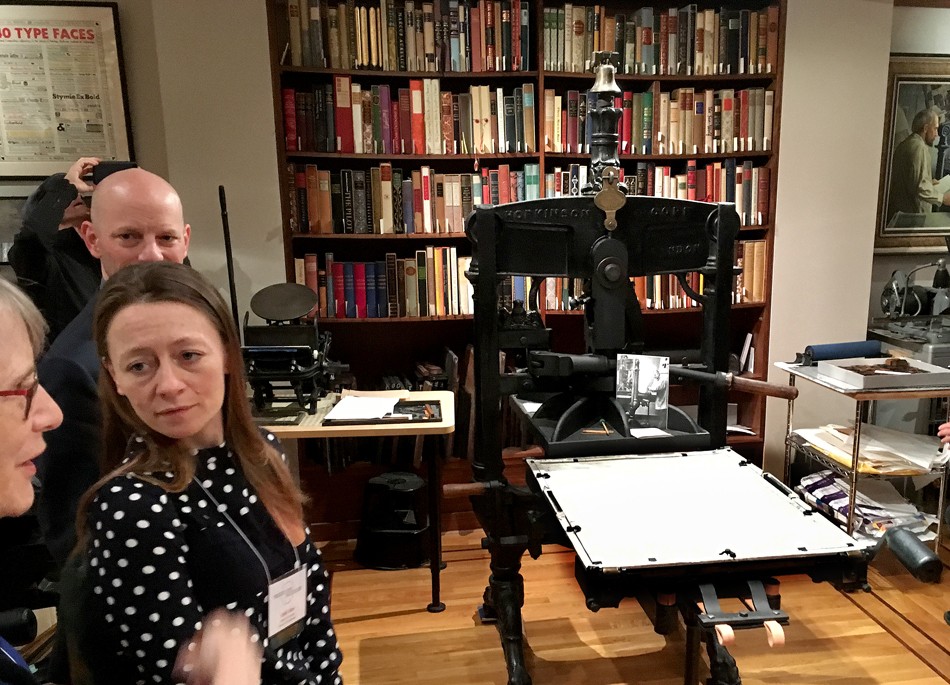 Making an Impression: Taking center stage for visitors is the famed Kelmscott/Goudy iron hand-press featured among other working presses in the Arthur M. Lowenthal Memorial Pressroom within the Cary Graphics Arts Collection at RIT. Visitors learned it was first owned by the English printer William Morris and then Frederic Goudy, two giants of the letterpress printing art. The press was built in London in 1891 by Hopkinson & Cope- an Improved Albion model (No. 6551). Now featuring around 40,000 fine and rare volumes on graphic communication history and practices, The Cary Collection is considered one of the premier libraries on the subject in the United States. ( library.rit.edu/cary ) David Spencer for PhotoSeed Archive
Making an Impression: Taking center stage for visitors is the famed Kelmscott/Goudy iron hand-press featured among other working presses in the Arthur M. Lowenthal Memorial Pressroom within the Cary Graphics Arts Collection at RIT. Visitors learned it was first owned by the English printer William Morris and then Frederic Goudy, two giants of the letterpress printing art. The press was built in London in 1891 by Hopkinson & Cope- an Improved Albion model (No. 6551). Now featuring around 40,000 fine and rare volumes on graphic communication history and practices, The Cary Collection is considered one of the premier libraries on the subject in the United States. ( library.rit.edu/cary ) David Spencer for PhotoSeed Archive
 Alternate History: The coverage by war photographer Robert Capa (1913-1954) for Life Magazine of American troops landing on Omaha Beach on D-Day during World War II was deconstructed after seven decades of public myth to facts by Staten Island, NY independent critic and historian A. D. Coleman. The first photo critic for the New York Times in 1967 and prolific author of books on photography as well as thousands of articles on the medium, Coleman presented his research during the conference titled “Deconstructing Robert Capa’s D-Day: The Unmaking of a Myth” that recently took place over three years helped by the efforts of war photographer J. Ross Baughman, Rob McElroy and Charles Herrick. As a former photojournalist myself for over three decades, I found his presentation convincing and enlightening: I still remember drying strips of film as a young photographer in large upright darkroom cabinets-the focus of some of the research when it was claimed a Life lab tech had melted Capa's film on deadline- the worst I remember was curled film! Please visit capaddayproject.com to learn more. Malcolm Gladwell, (revisionisthistory.com) are you interested? David Spencer for PhotoSeed Archive
Alternate History: The coverage by war photographer Robert Capa (1913-1954) for Life Magazine of American troops landing on Omaha Beach on D-Day during World War II was deconstructed after seven decades of public myth to facts by Staten Island, NY independent critic and historian A. D. Coleman. The first photo critic for the New York Times in 1967 and prolific author of books on photography as well as thousands of articles on the medium, Coleman presented his research during the conference titled “Deconstructing Robert Capa’s D-Day: The Unmaking of a Myth” that recently took place over three years helped by the efforts of war photographer J. Ross Baughman, Rob McElroy and Charles Herrick. As a former photojournalist myself for over three decades, I found his presentation convincing and enlightening: I still remember drying strips of film as a young photographer in large upright darkroom cabinets-the focus of some of the research when it was claimed a Life lab tech had melted Capa's film on deadline- the worst I remember was curled film! Please visit capaddayproject.com to learn more. Malcolm Gladwell, (revisionisthistory.com) are you interested? David Spencer for PhotoSeed Archive
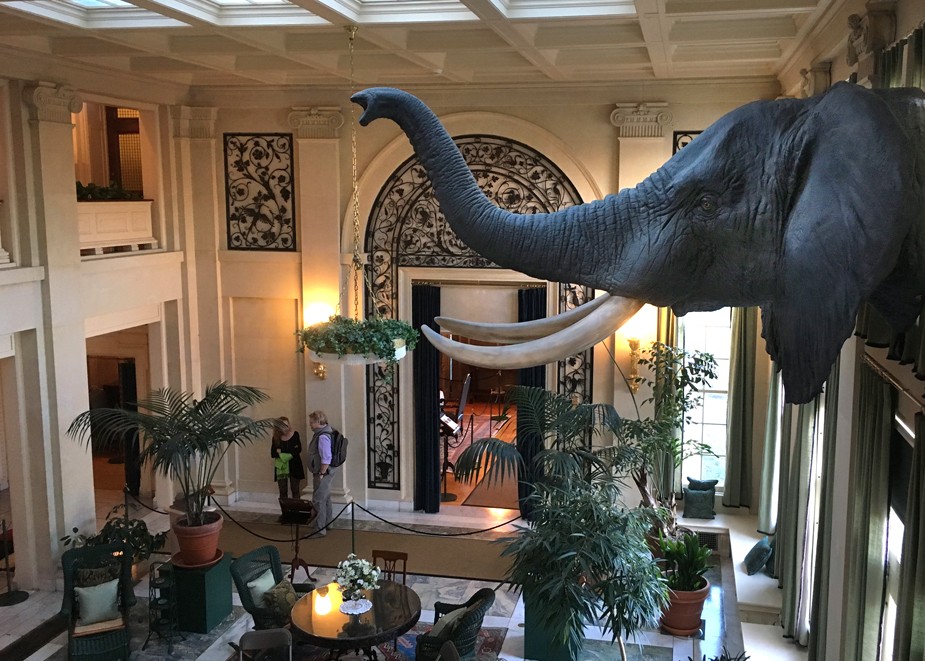 Digital Elephant in Room: Visitors to George Eastman's stately 50-room Colonial revival mansion adjoining the Eastman Museum will always remember the conservatory, where a fiberglass replica mount of an African bull elephant hangs- a conquest by the company founder during a 1928 Sudanese safari. Conveniently- and speaking of elephants in the room, I earlier had thoroughly enjoyed listening and pondering conference presenter Stephen Fletcher's talk: “The Photographic Archivist is Dead, Long Live the Photographic Archivist!”, his call to action for the task of photo archivists in the 21st Century: what do we do and how do we preserve a portion for posterity and history the digital evidence of billions and billions of photographs taken-seemingly, every day? A photographic archivist in the North Carolina collection at the University of North Carolina at Chapel Hill, Fletcher's call to arms would surely have inspired Eastman himself, a hands-on guy who is reported to have overseen every aspect of the construction of his mansion and made sure it contained all the cutting-edge technology of its' day: from the Eastman Museum website: "Beneath this exterior were modern conveniences such as an electrical generator, an internal telephone system with 21 stations, a built-in vacuum cleaning system, a central clock network, an elevator, and a great pipe organ, which made the home itself an instrument, a center of the city’s rich musical life from 1905 until Eastman’s death in 1932. Eastman was involved in every aspect of the construction, paying close attention to detail and requiring the use of high-quality materials." David Spencer for PhotoSeed Archive
Digital Elephant in Room: Visitors to George Eastman's stately 50-room Colonial revival mansion adjoining the Eastman Museum will always remember the conservatory, where a fiberglass replica mount of an African bull elephant hangs- a conquest by the company founder during a 1928 Sudanese safari. Conveniently- and speaking of elephants in the room, I earlier had thoroughly enjoyed listening and pondering conference presenter Stephen Fletcher's talk: “The Photographic Archivist is Dead, Long Live the Photographic Archivist!”, his call to action for the task of photo archivists in the 21st Century: what do we do and how do we preserve a portion for posterity and history the digital evidence of billions and billions of photographs taken-seemingly, every day? A photographic archivist in the North Carolina collection at the University of North Carolina at Chapel Hill, Fletcher's call to arms would surely have inspired Eastman himself, a hands-on guy who is reported to have overseen every aspect of the construction of his mansion and made sure it contained all the cutting-edge technology of its' day: from the Eastman Museum website: "Beneath this exterior were modern conveniences such as an electrical generator, an internal telephone system with 21 stations, a built-in vacuum cleaning system, a central clock network, an elevator, and a great pipe organ, which made the home itself an instrument, a center of the city’s rich musical life from 1905 until Eastman’s death in 1932. Eastman was involved in every aspect of the construction, paying close attention to detail and requiring the use of high-quality materials." David Spencer for PhotoSeed Archive
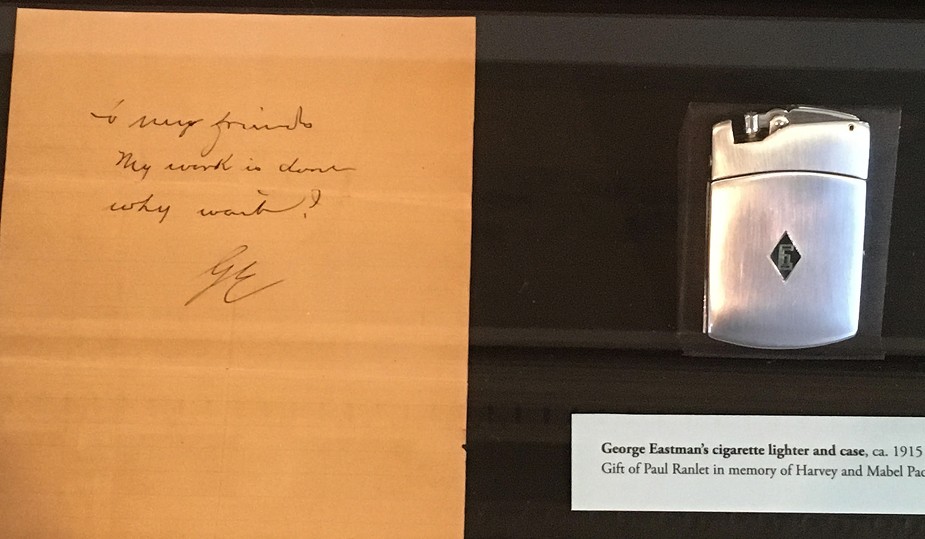 Smoking also Works: Perhaps the most startling object on display in the mansion-at least to those who do not know the intimate details of George Eastman's life- is a facsimile of his 1932 suicide note: "To my friends - My work is done - why wait? GE." Suppressed initially by the Eastman Kodak Company for decades, this news is sobering but important. Eastman had been crippled by a degenerative spinal disease and unable to walk, he shot himself through the heart in his upstairs bedroom. A music lover even after the end, a 1990 New York Times story on the renovation of the mansion noted he "requested a rousing ''Marche Romaine'' by Charles Gounod be played at his funeral". David Spencer for PhotoSeed Archive
Smoking also Works: Perhaps the most startling object on display in the mansion-at least to those who do not know the intimate details of George Eastman's life- is a facsimile of his 1932 suicide note: "To my friends - My work is done - why wait? GE." Suppressed initially by the Eastman Kodak Company for decades, this news is sobering but important. Eastman had been crippled by a degenerative spinal disease and unable to walk, he shot himself through the heart in his upstairs bedroom. A music lover even after the end, a 1990 New York Times story on the renovation of the mansion noted he "requested a rousing ''Marche Romaine'' by Charles Gounod be played at his funeral". David Spencer for PhotoSeed Archive
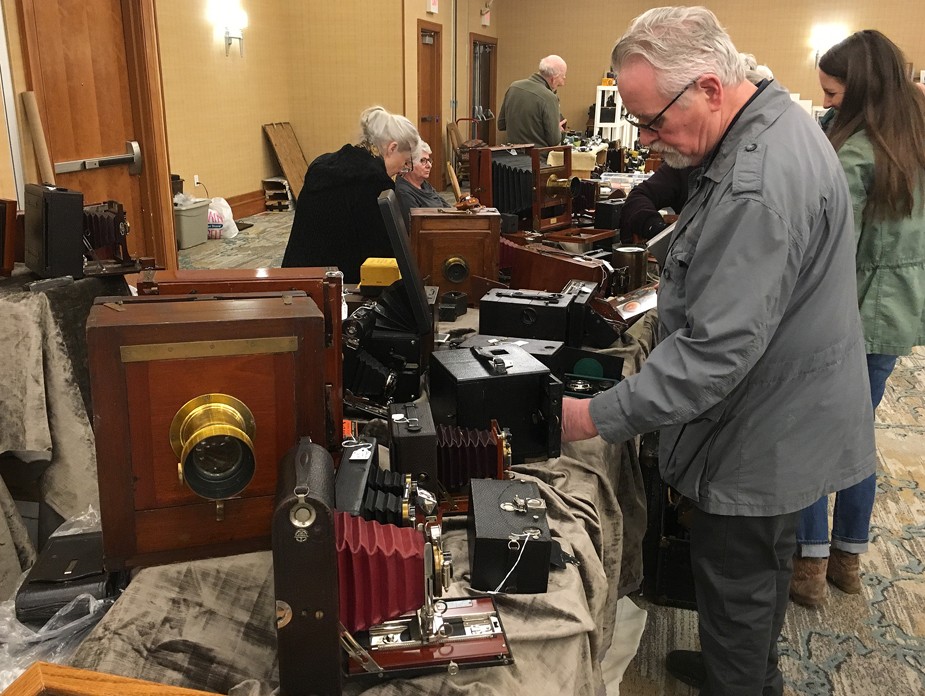 Fancy Box with Hole in It: Collectors and the curious had the opportunity to peruse the physical evidence of the history of photography during the concluding event of the conference, an antiquarian photography show and sale featuring 80 tables of wares including these vintage wooden box and Kodak cameras. Earlier, the RIT Press and Syracuse University Press showed off their latest offerings, including some wonderful photography volumes during the event. David Spencer for PhotoSeed Archive
Fancy Box with Hole in It: Collectors and the curious had the opportunity to peruse the physical evidence of the history of photography during the concluding event of the conference, an antiquarian photography show and sale featuring 80 tables of wares including these vintage wooden box and Kodak cameras. Earlier, the RIT Press and Syracuse University Press showed off their latest offerings, including some wonderful photography volumes during the event. David Spencer for PhotoSeed Archive
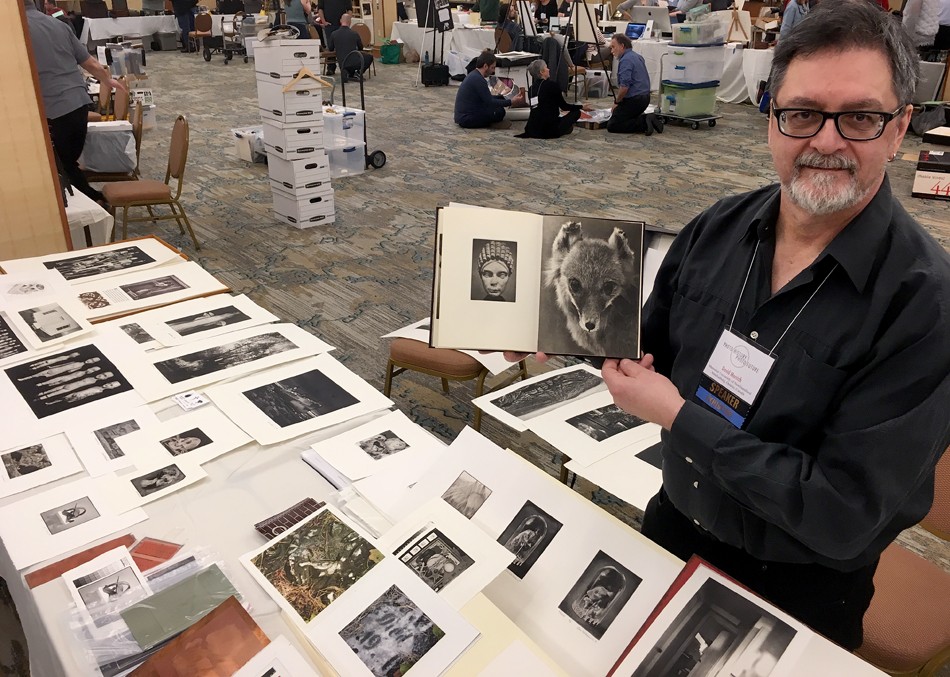 Learned from Jon Goodman: During the antiquarian photography show and sale, Ontario-based visual artist David Morrish, co-author along with Marlene MacCallum of the 2003 volume "Copper Plate Photogravure: Demystifying the Process", shows off a page spread of original photogravures from his 2004 Deadcat Press imprint "Gaze" he was selling along with other work during the antiquarian photography show and sale. Earlier in the conference, Morrish and visual artist MacCallum, former professor in the Visual Arts Program at Memorial University of Newfoundland, presented on "Photogravure: Then and Now" highlighting the gravure process while showing how the medium’s ongoing relevance to contemporary art practice has influenced their own work in the production of print suites and artists’ books. Learn more at marlenemaccallum.com and davidmorrish.com. David Spencer for PhotoSeed Archive
Learned from Jon Goodman: During the antiquarian photography show and sale, Ontario-based visual artist David Morrish, co-author along with Marlene MacCallum of the 2003 volume "Copper Plate Photogravure: Demystifying the Process", shows off a page spread of original photogravures from his 2004 Deadcat Press imprint "Gaze" he was selling along with other work during the antiquarian photography show and sale. Earlier in the conference, Morrish and visual artist MacCallum, former professor in the Visual Arts Program at Memorial University of Newfoundland, presented on "Photogravure: Then and Now" highlighting the gravure process while showing how the medium’s ongoing relevance to contemporary art practice has influenced their own work in the production of print suites and artists’ books. Learn more at marlenemaccallum.com and davidmorrish.com. David Spencer for PhotoSeed Archive
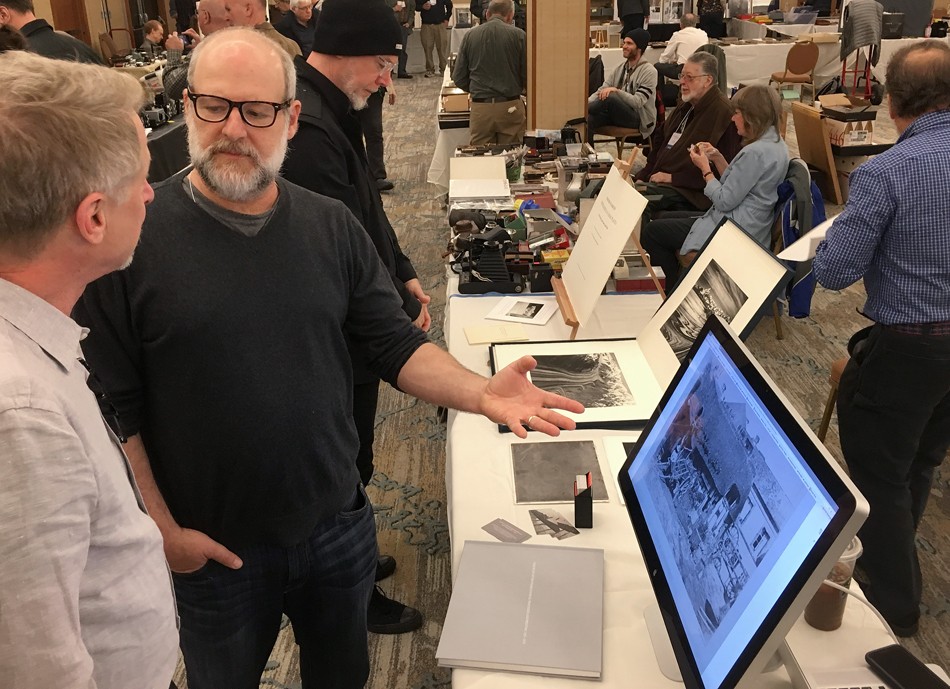 Future with a Past: St. Louis resident and commercial photographer Mark Katzman, the key force in proselytizing for the medium and beauty of hand-pulled photogravure worldwide through his website Photogravure.com, speaks with conference speaker Jeff Rosen during the antiquarian photography show and sale. Curious to learn what a real photogravure is, unlike the many who simply use the term-wrongly-to sell you something not what they claim? Head over to his newly redesigned site, where the mission statement is: "Peeling back a layer of the history of photography, this site examines the role that photogravure has played in shaping our shared visual experience. Through exploring thousands of examples, we learn about the relentless and ambitious 19th century pursuit to reproduce photographs in ink and discover the exquisite, sublime process that resulted. It is our hope that this site firmly establishes photogravure as not only one of the most under-recognized photographic processes, but also an important and beautiful art." David Spencer for PhotoSeed Archive
Future with a Past: St. Louis resident and commercial photographer Mark Katzman, the key force in proselytizing for the medium and beauty of hand-pulled photogravure worldwide through his website Photogravure.com, speaks with conference speaker Jeff Rosen during the antiquarian photography show and sale. Curious to learn what a real photogravure is, unlike the many who simply use the term-wrongly-to sell you something not what they claim? Head over to his newly redesigned site, where the mission statement is: "Peeling back a layer of the history of photography, this site examines the role that photogravure has played in shaping our shared visual experience. Through exploring thousands of examples, we learn about the relentless and ambitious 19th century pursuit to reproduce photographs in ink and discover the exquisite, sublime process that resulted. It is our hope that this site firmly establishes photogravure as not only one of the most under-recognized photographic processes, but also an important and beautiful art." David Spencer for PhotoSeed Archive
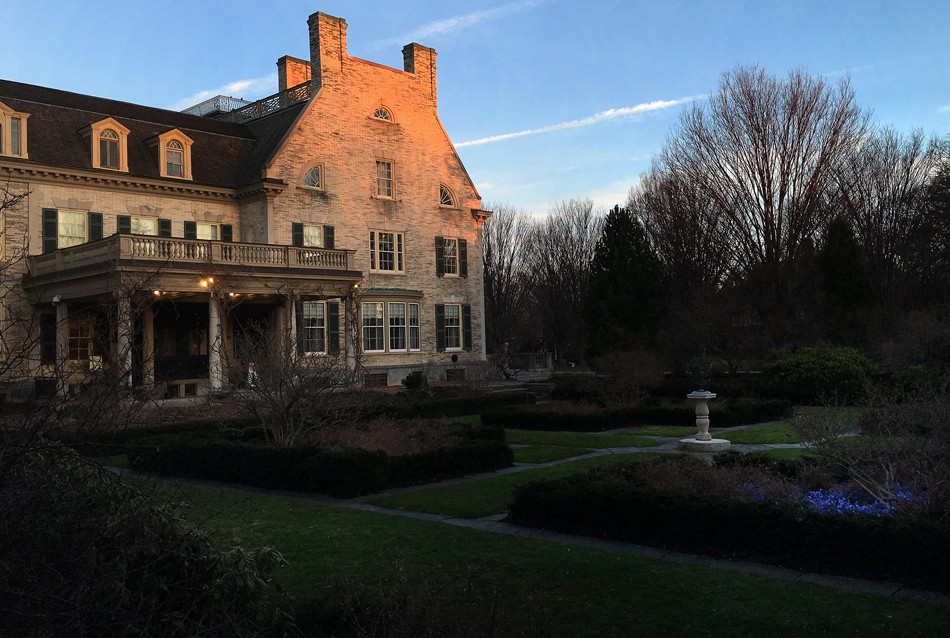 Keeper of Memories: Located at 900 East Ave. in Rochester, New York, the George Eastman Museum, along with a section of his original mansion and gardens on 8.5 acres constructed beginning in 1902, is a grand American repository for the study of photography past, present and future. Besides a growing archive of over 400,000 photographic objects spanning the history of the medium, the museum also features 16,000 + examples of photographic and cinematographic technology- the world's largest. For those interested in the printed legacy, the accessible Richard and Ronay Menschel Library is also onsite, with a special collections and archive division housing "manuscripts, papers, and ephemera, including those of Alvin Langdon Coburn, Lewis W. Hine, Southworth and Hawes, and Edward Steichen, among other photographers, collectors, and inventors." Curious? eastman.org. David Spencer for PhotoSeed Archive
Keeper of Memories: Located at 900 East Ave. in Rochester, New York, the George Eastman Museum, along with a section of his original mansion and gardens on 8.5 acres constructed beginning in 1902, is a grand American repository for the study of photography past, present and future. Besides a growing archive of over 400,000 photographic objects spanning the history of the medium, the museum also features 16,000 + examples of photographic and cinematographic technology- the world's largest. For those interested in the printed legacy, the accessible Richard and Ronay Menschel Library is also onsite, with a special collections and archive division housing "manuscripts, papers, and ephemera, including those of Alvin Langdon Coburn, Lewis W. Hine, Southworth and Hawes, and Edward Steichen, among other photographers, collectors, and inventors." Curious? eastman.org. David Spencer for PhotoSeed Archive
Tripod not Optional
Posted July 2012 in New Additions, Photographic Preservation
Commemorative events in world history recorded in the early years of photography were entirely documentary, with the brutal results being a kind of topographical portraiture not often appreciated by modern viewers, at least for the efforts expended on behalf of their makers.
 Detail: Frances V. Stevens: American: 1893: "Gondolier passing Statue of the Republic" in Grand Basin of the World's Columbian Exposition held in Chicago. In background can be seen Peristyle from Liberal Arts building which overlooked Lake Michigan: vintage mounted gelatin-silver photograph: 10.8 x 9.5 cm: PhotoSeed Archive
Detail: Frances V. Stevens: American: 1893: "Gondolier passing Statue of the Republic" in Grand Basin of the World's Columbian Exposition held in Chicago. In background can be seen Peristyle from Liberal Arts building which overlooked Lake Michigan: vintage mounted gelatin-silver photograph: 10.8 x 9.5 cm: PhotoSeed Archive
Industrial and world expositions come to mind: the 1867 Exposition Universelle in Paris and 1876 Centennial International Exhibition in Philadelphia being some of the better known. Before the very early 1880’s, when the dry plate came into wide use, photographers attending these expositions would need a portable darkroom and chemicals mixed on the spot for the coating of glass plates- quickly inserted into the back of their tripod-mounted cameras in order to make an exposure. Major hurdles typically not ventured by the average photographer.
Enter the 1893 World’s Columbian Exposition held in Chicago, and the wide availability by then of dry plates and roll film for the teeming photographic masses. 1892 marked the 400th anniversary of Christopher Columbus’s arrival in North America and its’ commemoration from May to October the following year attracted over 27 million people from around the world. But so-called “serious” photography practiced there, along with capitalistic motive by those in charge, conspired against the dedicated photographer attending. With the exception of practical solutions for photographers in the form of railings, pedestals or fixed objects, only one attendee was allowed the luxury of lugging a camera tripod around the 600+ acre fairgrounds, Charles Dudley Arnold, (1844-1927) designated the World’s Fair Official Photographer.
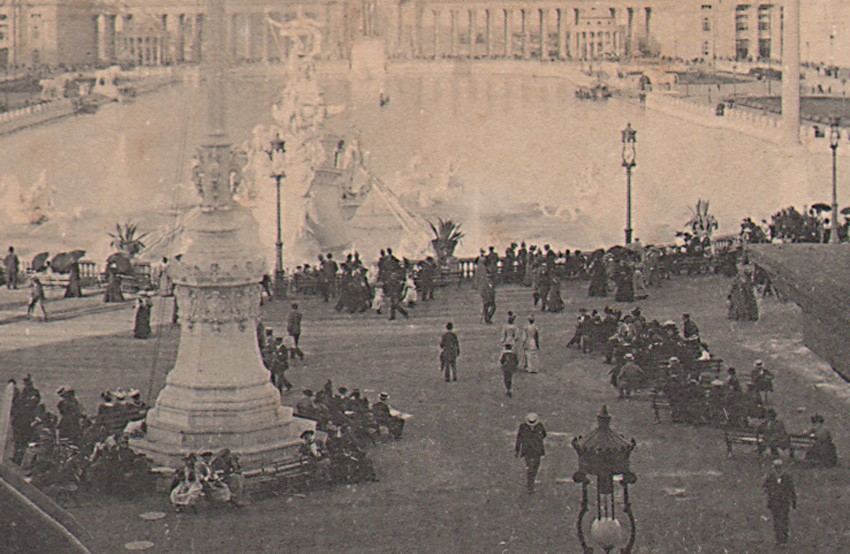 Detail: Frances V. Stevens: American: 1893: "People Congregating in Court of Honor" on east side of Administration Building overlooking the Grand Basin at World's Columbian Exposition held in Chicago. vintage mounted gelatin-silver photograph: 9.2 x 12.1 cm: PhotoSeed Archive
Detail: Frances V. Stevens: American: 1893: "People Congregating in Court of Honor" on east side of Administration Building overlooking the Grand Basin at World's Columbian Exposition held in Chicago. vintage mounted gelatin-silver photograph: 9.2 x 12.1 cm: PhotoSeed Archive
Tripods aside, the biggest obstacle was financial, as a daily permit was required. After shelling out .50¢ for daily admission, someone intent on photographing the grandeur of the Chicago fair needed to pay an additional $2.00 for the privilege, almost $50.00 in today’s currency.
“Of course, any one who pays the required $2 can obtain a permit to photograph in the World’s Fair grounds with a four-by-five (or smaller) camera, and without a tripod” ,
the Photographic Times helpfully informed its readership on September 22, 1893.
One person who had no problems with the price of a daily photographic permit was Miss Frances V. Stevens of New York City. A world traveler, she was an active and exhibiting member of the New York Camera Club as early as 1891 according to The American Amateur Photographer. Her society credentials were equally impressive, with the New York Times mentioning her in a July, 1890 article along with Louise Whitfield Carnegie, the spouse of Andrew Carnegie, one of the world’s richest people: “Among the New York ladies who are amateur photographers are Mrs. Andrew Carnegie, … Miss Frances V. Stevens” it stated.
 Detail: Frances V. Stevens: American: 1893: at right: "Entrance to the Fisheries Arcade" (Henry Ives Cobb): a bullfrog can be seen peering out from a riot of frogs on the set of columns at right on the grounds of World's Columbian Exposition held in Chicago. This ornamental hand-work was made from staff, composed of plaster, cement, and jute fibers. Vintage mounted gelatin-silver photograph: 10.5 x 9.8 cm: PhotoSeed Archive
Detail: Frances V. Stevens: American: 1893: at right: "Entrance to the Fisheries Arcade" (Henry Ives Cobb): a bullfrog can be seen peering out from a riot of frogs on the set of columns at right on the grounds of World's Columbian Exposition held in Chicago. This ornamental hand-work was made from staff, composed of plaster, cement, and jute fibers. Vintage mounted gelatin-silver photograph: 10.5 x 9.8 cm: PhotoSeed Archive
Six surviving examples of photographs taken by Frances Stevens, all signed by her and taken at the 1893 World’s fair, have now been added to the site. Believed to be contact-prints from cut or reduced 4 x 5” negatives, they had originally been individually framed. Improper storage has also taken a toll on the work and they each exhibit a large amount of surface staining-but not enough to preclude their artistic and historical importance from being seen here.
Even in the reduced format, the Stevens prints are chock full of nuance, and I’ve taken the liberty of showing details from select examples to illustrate this post. In many ways, her less scripted results by means of the smaller hand camera are extremely valuable documents-certainly in regards to artistic consideration-but equal in different ways to many of those captured by one of Charles Arnold’s 11 x 14 inch plate cameras. In consideration of preservation issues and speaking of the wonder of large glass plate negatives in general, a vast secret life waits to be uncovered by historians willing to take the time to save this material. Something crucial and I dare say almost too late for one of humankind’s greatest achievements, her invention of photography.
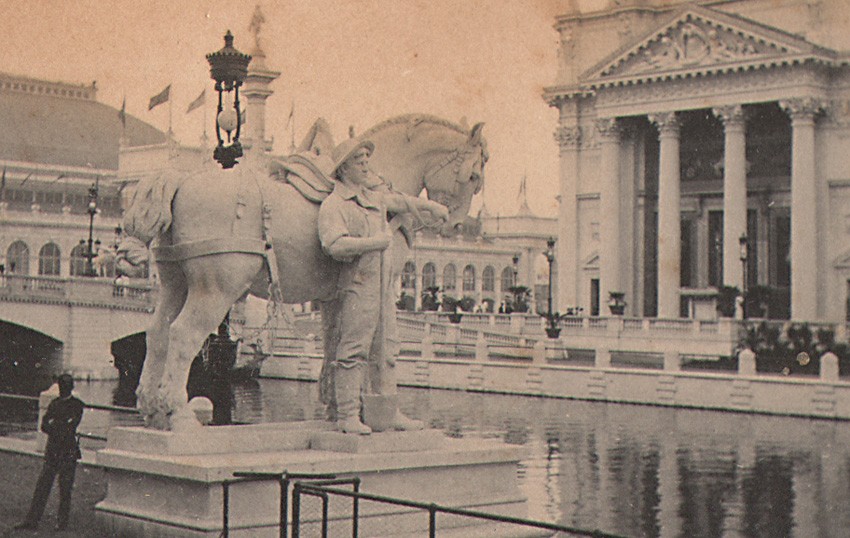 Detail: Frances V. Stevens: American: 1893: "Statue of Industry" by American sculptor Edward Clark Potter (1857-1923): statue overlooks South Basin with part of the Manufactures and Liberal Arts Building seen on left and Agriculture Building at right. vintage mounted gelatin-silver photograph: 9.2 x 11.8 cm: PhotoSeed Archive
Detail: Frances V. Stevens: American: 1893: "Statue of Industry" by American sculptor Edward Clark Potter (1857-1923): statue overlooks South Basin with part of the Manufactures and Liberal Arts Building seen on left and Agriculture Building at right. vintage mounted gelatin-silver photograph: 9.2 x 11.8 cm: PhotoSeed Archive
If one were willing and intrigued by the idea however, photographic archives from newspapers around the world dating to the early 20th century can be a wonderful starting point. For those seeking evidence and inspiration with respect to digital preservation, please check out Springfield Photographs, a site concentrating on the Midwestern American experience from 1929-1935 and most worthy of your attention.